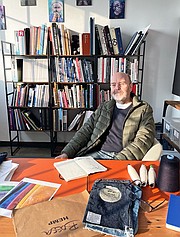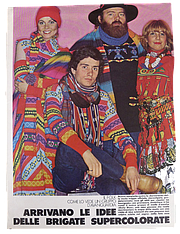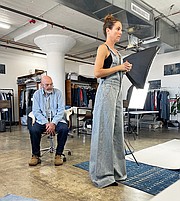BACK TO THE FUTURE
With the Relaunch of Daily Blue, the Godfather of Denim Will Never Retire
Photo Gallery
With the Relaunch of Daily Blue, the Godfather of Denim Will Never Retire
Photos courtesy of Daily Blue
A great pair of jeans gets better with age, and the same goes for Adriano Goldschmied. The pioneering Italian designer, who’s made his home in Los Angeles since 1996, has never stopped chasing the muse of inspiration and innovation. His curriculum vitae includes founding Diesel, collaborating with Citizens of Humanity and Gap’s 1969 line in addition to his own eponymous brand.
Now the man known as the godfather of premium denim is coming full circle and returning to where it all began. Daily Blue was his first pioneering venture in the early ’70s when the word “jeans” mostly meant Levi’s, Lee and Wrangler.
California Apparel News connected with the legendary designer while he was spending the new year’s vacation in the Italian alps to get the scoop on his latest—and oldest—foray into the world of denim.
CAN: Why did you leave Daily Blue, and why are you bringing it back?
AG: Daily Blue is a very important brand because it was the first in the ’70s to bring fashion into denim with colors and new ideas. It was immediately global and was probably a good inspiration for many designers who came after, showing it was possible to make money and have a fashion concept in denim.
I left in ’78 because I already had in my mind the Genius Group. I was young and enthusiastic and oriented toward new things, and that’s the reason why I left a successful business for another venture that, thank God, was even more successful and another milestone in denim.
At the beginning of 2022 a friend reminded me of what I did in the ’70s and so I got the idea of repeating the experience, not so much the design but the fashion direction, enthusiasm and sense of innovation. That’s what I’d like to bring back with Daily Blue and was lucky to find that the trademark registration was available all over the world. After that, we began working like crazy, just like we did in ’74.
CAN: How do you maintain your enthusiasm for this fabric after so many decades?
AG: That’s a question I’ve asked myself many times, and the answer is very simple: Denim is a very special fabric. Like a white canvas for an artist, it can be used in many ways, and you can create a link between the consumer and the fabric because when you wear it the jean takes your shape based on what you do and how you wear it. So jeans are always finding a way to be new. We invented new washes, new finishes, and every year we bring innovation and never get tired.
CAN: Today there’s a trend among the young for destroyed jeans. Do you find this a kind of disrespecting of the artist’s canvas?
AG: Not at all. It’s just a phase of the many changes you can make with denim. For the last 10 years it has been skinny jeans, and for 10 years earlier it was about the boot cut. Today is completely different as we have many different fits and finally the consumer can choose what works well for their body and personality.
CAN: From the origins in the ’70s through the designer-jeans phase of the ’80s and the premium craze of the early 2000s, where is denim now?
AG: It’s completely different between now and the past: Consumers are not dictated by brands. The internet came into our business with dramatic power and has changed the rules completely. Today I can talk to my customers in Osaka [Japan] and get feedback directly, and this has made our business so exciting again.
CAN: You’re always talking about the future. As we begin the new year, what are your hopes for 2023?
AG: Daily Blue is a baby I have to babysit, so that’s the most important thing for 2023 in addition to running my design studio with very important customers such as Chloe. My goal is always the same—bring innovation to make new things and make people love denim.
Another thing that’s important is sustainability and circularity. However, in the end we’re in the fashion business, and I don’t think the consumer is making a decision about whether something is sustainable or not. They pick something they think is good for them, go into the changing room, and the mirror makes the final decision. So we have to do two things that are very important: make fashion that makes the consumer happy but also make it in the right way. Sustainability doesn’t have to be just a marketing tool but a reality of production. It’s like you don’t say, “I’m honest,” every five minutes; it’s a practice and is what it is.
CAN: At this stage of your career, what will success mean for you with Daily Blue?
AG: To have a leading position in the market with a presence in the best stores in the world. Basically opening a new concept that is—I don’t know what to call it—maybe luxury premium. A product above traditional premium, which to be honest isn’t premium anymore; it’s not about innovation and quality, which is what drives my work. This will probably be more expensive than regular premium denim but have more value.
CAN: What would you most like to be remembered for?
AG: More than the brands, it’s been about teaching people. We invented the laundry business, we created a school of designers, and in the early ’90s we were the first to think about sustainability. These are the things I believe I changed in the industry.
CAN: What will make you retire?
AG: I don’t plan to retire. What I like is to keep working on innovation, to have around me a team that is learning and keeping our business alive.
CAN: Do you have a personal hero? Not necessarily in fashion, but perhaps an artist or filmmaker?
AG: Andy Warhol. He wore jeans every day and invented the marketing of art. He connected the product to communication 50 years ago, exactly what is happening today.
Photos courtesy of Daily Blue.


























